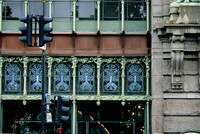| dc.coverage.spatial | Site: Saint Petersburg, Rossiya, Russia | en_US |
| dc.coverage.temporal | ca. 1901-1906 (creation) | en_US |
| dc.creator | Baranovsky, Gavriil | en_US |
| dc.creator | Adamson, Amandus | en_US |
| dc.date | 1901-1906 | en_US |
| dc.date.accessioned | 2013-01-16T14:50:40Z | |
| dc.date.available | 2013-01-16T14:50:40Z | |
| dc.date.issued | 1901-1906 | en_US |
| dc.identifier | 183847 | en_US |
| dc.identifier.other | archrefid: 1680 | en_US |
| dc.identifier.uri | http://hdl.handle.net/1721.3/91240 | |
| dc.description | Ground floor window on Nevsky Prospect, detail showing decorative stained glass and cast iron work; Baranovsky made his reputation designing shops in the Art Nouveau style in Moscow and St Petersburg for the wealthy merchant G. G. Yeliseyev [also rendered Eliseyev, Yeliseyev, Eliseeff]. After the creation of the Yeliseyev Pavilion at the All-Russian Arts and Industrial Exhibition (1896) in Nizhny Novgorod, Baranovsky began construction of the shop, theatre and restaurant complex (1902-1906; now Gastronom No. 1 and the Comedy Theatre) at the Yeliseyev trading house, 58 Nevsky Prospect, St Petersburg. The shop has a marvellous Art Nouveau interior, which makes decorative use of glass, metal, stained glass and glazed ceramics, and a grandiose Baroque Revival façade, which includes colossal allegorical figures by Amandus Adamson. The proportions of the building correspond to Karl Rossi’s Aleksandrinsky (now Pushkin) Theatre opposite, which was built in 1828-1832. Source: Grove Art Online; http://www.oxfordartonline.com/ (accessed 6/16/2009) | en_US |
| dc.format.medium | granite; stained glass; bronze statues | en_US |
| dc.rights | © Scott Gilchrist, Archivision, Inc. | en_US |
| dc.subject | allegorical | en_US |
| dc.subject | architectural exteriors | en_US |
| dc.subject | business, commerce and trade | en_US |
| dc.subject | decorative arts | en_US |
| dc.subject | Performing arts | en_US |
| dc.subject | Style-Moderne | en_US |
| dc.subject | gourmet foods | en_US |
| dc.subject | retail shops | en_US |
| dc.subject | entertainment complex | en_US |
| dc.subject | Art Nouveau | en_US |
| dc.subject | Twentieth century | en_US |
| dc.subject | Baroque Revival | en_US |
| dc.title | Yeliseyev Trading House | en_US |
| dc.title.alternative | Yeliseev's | en_US |
| dc.title.alternative | Elisseeff Emporium | en_US |
| dc.type | image | en_US |
| dc.rights.access | Licensed for educational and research use by the MIT community only | en_US |
| dc.identifier.vendorcode | 1A1-BGA-Y-B3 | en_US |
| vra.culturalContext | Russian | en_US |
| vra.technique | construction (assembling) carving (processes) stained glass | en_US |
| vra.worktype | department store | en_US |
| vra.worktype | theater (building) | en_US |
| dc.contributor.display | Amandus Adamson (Estonian sculptor, 1855-1929); Gavriil Baranovsky (Russian architect, born 1860, died ca. 1918-1923) | en_US |


